My
first visit to Big Bend National Park was only for a few days at the end of April 2010. It's so big and there was so much more to see and do, I decided to drop by again. Well, you don't really just "drop by"
Big Bend National Park. It's on the way to no where.
 |
| The Persimmon Gap (north) Entrance |
Since my 2010 visit, the park has been in a severe drought and also had a rare hard freeze a year ago, in the single digits. So, the plants are not very happy right now. The animals, right up the food chain, are very stressed. The deer, javelinas and other small animals don't have enough to forage on; thus, their populations are dropping. As a result, the bears and cougars don't have enough prey to survive.
 |
The lechuguilla in the foreground should be green, but as a result of the
drought and freeze, they are a sickly yellow and easily uprooted by javelina.
Looking toward the Chisos from K-Bar 2, backcountry campsite. |
Unfortunately, a sickly
young mountain lion attacked a 6yo boy near the lodge on the 5th, inflicting non-life-threatening injuries. In addition, several other park patrons saw this same cat and chased it away. As late as yesterday, I saw park officials hunting the cougar with dogs and, when found, I'm told they will kill it.
 |
Mountain Lion display at the Chisos Basin
Visitor Center. |
Big Bend is 3 parks in one. First, it's mostly desert, the
Chihuahuan desert to be exact. Second, the Chisos Range provide a small oasis-like mountainous environment. Third, the Rio Grande River forms its "big bend" on the parks southern edge. In 2010, I stayed in developed campgrounds -- on the Rio Grande and in Chisos Basin. This time around I stayed at a couple of back-country campsites in the desert -- K-Bar and Paint Gap. I had no amenities, but $10 for 14 days is a great deal ... and everything is within easy driving distance.
 |
| Sunset and moon rise at my Paint Gap campsite. |
And "everything" includes a post office, small grocery stores, visitor centers, gas stations, a laundromat, showers, 2 free wifi hotspots, and a lodge with restaurant. So, even though Big Bend is not close to any population centers, visitors in the park can find just about anything they need. My T-Mobile cell phone even worked in many places within the park.
 |
This peak is called Casa Grande. Notice the lodge below. The restaurant is
just to the left. (This is where the mountain lion attack occured.)
In this parking lot I got free wifi, there's a little store and a visitor's center. |
I was hoping to be able to visit Boquillas, a small Mexican village just across the river from Rio Grande Village. Unfortunately, since 9/11, border crossings have not been allowed. I'm told, however,that they'll be opening one to Boquillas in a couple of months. Next time I'm at Big Bend, I'll visit.
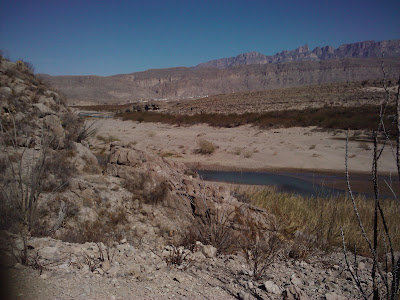 |
The Mexican Village of Boquillas (upper left), on the other side of
the Rio Grande River at the base of the Sierra del Carmen Mountains.
Taken from a view point on the Rio Grande Village Nature Trail. |
On a cold, cloudy day, I took an opportunity to drive to
Big Bend Ranch State Park to the west of the national park. I loved the road to the state park's entrance. It followed the Rio Grande River (also called the Rio Bravo del Norte). This two-lane road had grand vistas of the river, cliffs, hoodoos, mountains, and even a western movie set that you could explore. The river road followed up the canyon walls and down into the washes with lots of twists and turns ... my kind of road!
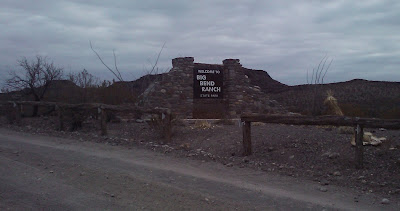 |
After 10 miles on a dirt road, I reach the "official" welcoming sign for
Big Bend Ranch State Park ...
only 17 more dirt-road miles to go to the visitors center! |
After about an hour-and-a-half drive, and a visit to Terlingua Ghost Town, I arrived at the turn off to the state park near the town of Presidio, TX. From this entrance, it was another 27 miles on dirt roads to the "heart" of the ranch where they maintain a demonstration heard of 70 long horn cattle. I was hoping to see them, but they were out on the range. Although the washboard roads were slow going, I thoroughly enjoyed the interior of Big Bend Ranch, especially the fantastic geological formations. I must say though, after 55 miles of bouncing up and down, and making sure I didn't bottom out any place, I was sure glad to exit the ranch and get back on smooth surface roads!
 |
On the way to the state park, I visited the Terlilingua Ghost Town Cemetery ...
it was an "odd" Ghost Town as most of the old buildings were occupied. |
I took lots of pictures of plants, sunsets, the mountains, the moon, architecture, and more ... here are a few for those that want more photos (click on them to bring up a bigger image) ...
Here are some pictures of the various mountains and peaks surrounding or in Big Bend National Park.
 |
Almost sunset, looking toward the Chisos Mountains,
the flat top of Casa Grande peak visable in the backgound.
Picture taken when almost to the turn off to my Paint Gap camp site. |
 |
A closer view of Casa Grande from the
Chisos Basin Loop Trail. |
 |
| The vista from the Window View Trail through "The Window" in Chisos Basin. |
 |
A view looking into the National Park from the west. At sunset.
Sierra del Carmen in the far background. Maybe Study Butte on the right. |
 |
Pic 1 of 2: Morning clouds pouring off the
Sierra del Carmen Mountains in the distance |
 |
| Pic 2 of 2: The clouds are gone in the afternoon. |
 |
A trail into the base of Santa Elena Canyon ... as far
as you can go ... off of the Ross Maxwell Scenic Drive. |
Here are some pictures of a bit of the facinating
geology of the area ...
 |
Painted Hills type of formation. Made from several volcanic ash falls.
On the road to Rio Grande Village. |
 |
Tuft Canyon (from volcanic ash), trail off the
Ross Maxwell Scenic Drive |
 |
Fossil Seashells seen on the Santa Elena Canyon Trail.
"Marine fossils prove this region was once beneath the sea
These oyster-like animals lived during the Cretaceous Period,
about 100 milion years ago." (trail sign) |
 |
On these peaks you can see layer upon layer of rock formed from lava, errosion,
ash, more lava, errosion and so forth. Makes for beautiful formations.
Seen on the Ross Maxwell Scenic Drive. |
 |
More interesting rock formations on the road into
Big Bend Ranch State Park. |
The various environments in the park make for some interesting
plant life ...
 |
This a pond full of plant and fish life, just off the Rio Grande River,
thanks to a couple of beaver dams.
As seen from the Rio Grande Village Nature Trail. |
 |
Coming up on an Aligator Juniper Tree on the
Chisos Basin Loop Trail. |
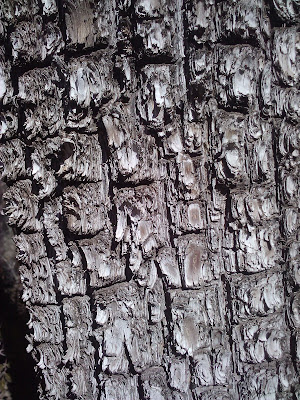 |
| The bark of the Aligator Juniper |
 |
This is a Drooping Juniper on the
Chisos Basin Loop Trail. |
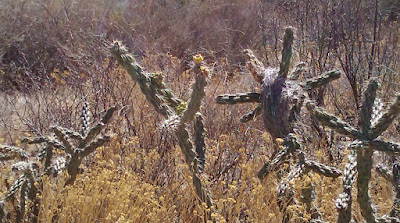 |
| A cactus getting ready to bloom on the Chisos Basin Loop Trail. |
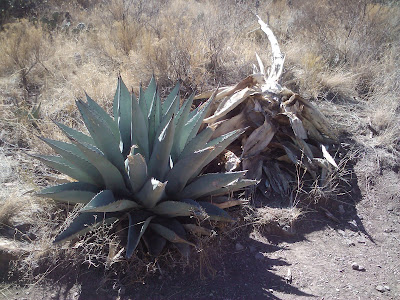 |
Agave. The one on the right has bloomed and died.
On the Chisos Basin Loop Trail. |
 |
Sotol in the foreground as seen at the Sotol Vista Overlook on the
Ross Maxwell Scenic Drive. |
Here are some sunsets and moon rises ...
 |
| Sunset from my first night at my Paint Gap campsite. |
 |
| Last night's sunset at Paint Gap |
 |
The pink of the sunset (from the west) reflected off the face of the
Sierra del Carmen mountains (in the east).
Taken from the Chihuahuan Desert Nature Trail at Dugout Wells. |
 |
Full moon starting to rise. Taken from the Chihuahuan Desert Nature
Trail at Dugout Wells |
 |
Full moon rising with ocotillo in foreground.
Taken from the Chihuahuan Desert Nature Trail at
Dugout Wells. |
The park is also full of cool architecture.
 |
| Windmill at Dugout Wells. |
 |
| Tunnel on road to Rio Grande Village |
 |
One of the bridges over the beaver dams.
Rio Grande Village Nature Trail |
 |
| Steps on the Rio Grande Village Nature Trail |
 |
Adobe brick building that use to be the La Harmonia Store in the
Castolon area of the park, off the Ross Maxwell Scenic Drive. |
 |
Switchbacks with railings created to climb the
Santa Elena canyon wall. |
 |
A natural hot springs was made into a pool with masonry for the
"Hot Springs Resort" of the 1930's. I took a break from my hike
and dangled my feet in the pool. Near Rio Grande Village. |
 |
| Many of the old "Hot Springs Resort" building still stand. |
Big Bend National Park has lots of
animals. I saw deer (white tale and mule), rabbits, javelinas, and maybe even a mountain lion from a far away distance. I saw a great blue heron, woodpeckers, roadrunners, nuthatchers, and other birds for whom I don't know their names. But, I didn't get any good pictures ... I'm not fast enough!
 |
Me waving "Hi Everyone" on a Tuft Canyon Overlook,
on a trail off of the Ross Maxwell Scenic Drive. |
Now, onward toward the Gulf Coast!










































































